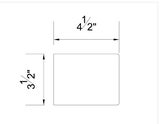- Men's Wallets
- >
- Beaver
- >
- Dam It • Chestnut • Bifold
Dam It • Chestnut • Bifold
SKU:
$329.00
$329.00
Unavailable
per item
Locally & Sustainably sourced Beaver Tail • Kangaroo
Features:
•6 Card slots
•2 Hidden Pockets
•1 Cash slot
•Full hand stitched
Dimensions: 4.5"W 3.5"T
The Good, The Bad, & The Ugly
The following information (found in quotations) has been sourced from the USDA at: USDA BEAVERS
"The American beaver (Castor canadensis) ... is known as an “ecosystem engineer” because of the benefits their dams provide to biological diversity and ecosystem function. It also is considered a “keystone species” because of its ability to transform its environment, creating new habitats upon which other species depend.
Despite the many positive benefits beavers provide through foraging and dam building, beavers also create conflict with people when their activities cause damage.
In general, beavers cause damage by:
A study in the late 1970s in Mississippi estimated annual loss to agriculture (including timber) at $2.5 million. Another Mississippi study estimated beaver damage to timber ranged from $25 to $118 per hectare, a potential annual economic loss of $215 million in 1985 U.S. dollars. A 2011 economic study evaluating Mississippi’s Beaver Control Assistance Program (BCAP) found that for every dollar spent on BCAP between $39.67 and $88.52 were saved from reduced beaver damage to timber and the state’s economy."
Despite the many positive benefits beavers provide through foraging and dam building, beavers also create conflict with people when their activities cause damage.
In general, beavers cause damage by:
- gnawing on trees or crops;
- flooding trees, crops, property, or transportation corridors (roads, airports, railways) through dam building;
- degrading and destabilizing banks and levees through burrowing
A study in the late 1970s in Mississippi estimated annual loss to agriculture (including timber) at $2.5 million. Another Mississippi study estimated beaver damage to timber ranged from $25 to $118 per hectare, a potential annual economic loss of $215 million in 1985 U.S. dollars. A 2011 economic study evaluating Mississippi’s Beaver Control Assistance Program (BCAP) found that for every dollar spent on BCAP between $39.67 and $88.52 were saved from reduced beaver damage to timber and the state’s economy."
Where Is Our Beaver Tail From?
At Teton Leather, we work with multiple suppliers and tanneries to find tails that are most typically from beavers that have been causing structural or environmental damage. Beaver Tails are a byproduct of forestry management and pest control. We also often work with tails that are sent to us directly by trappers. If you would like to use your own tail(s) for a project, please reach out directly.








